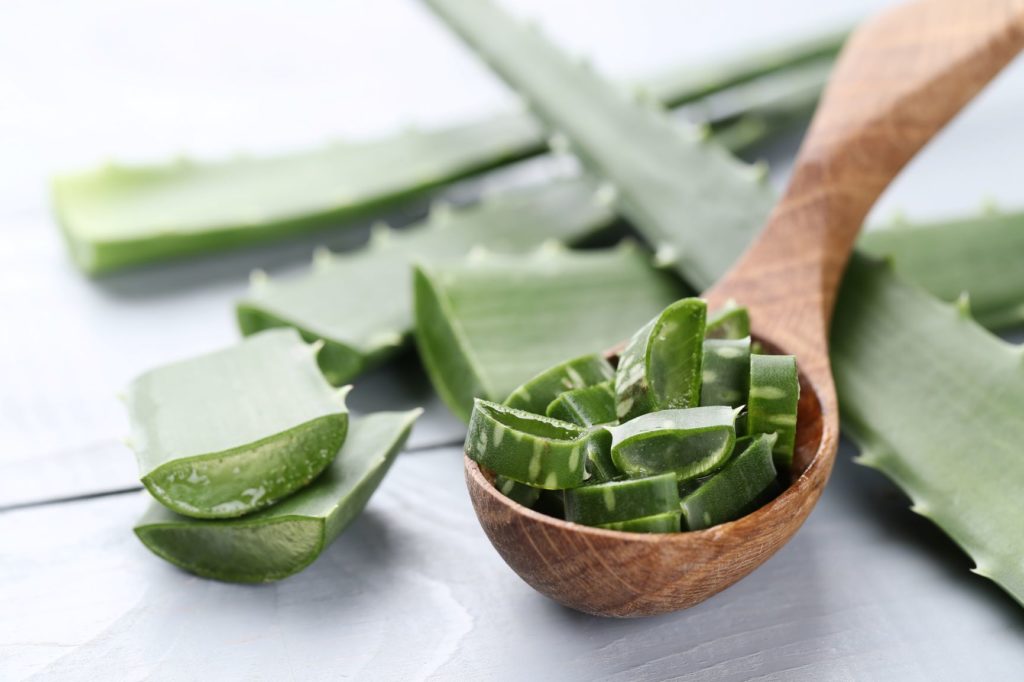When you’re looking at aloe vera products, do you know where the oil, gel, juice, or powder comes from? Believe it or not, over five hundred plant species have their own unique characteristics and uses.
In this article, we’ll discuss the most important types of aloe vera plants and the ways in which they are commonly (and not so commonly) used.
Aloe Vera (Aloe Barbadensis)
People sometimes use aloe vera as a catch-all term, but it’s a specific plant in the aloe family. If you grow an aloe vera plant in your home, chances are it’s this one. Featuring thick leaves with sharp edges, aloe vera (also called true aloe) is a popular home treatment for minor burns. You can tear off part of a leaf, squeeze the aloe vera gel onto a burn, and alleviate the pain with an immediate cooling sensation.
Organic aloe vera gel contains a diverse range of vitamins and minerals with multiple benefits. You can use aloe vera gel as first aid for skin issues, including irritation, inflammation, acne, and cleaning minor wounds. However, true aloe does contain latex, so it poses an allergy risk to some people.
At Aloe Laboratories, we grow, cultivate, and refine aloe barbadensis exclusively to produce high-quality consumer products for medical, health, and cosmetic purposes.
Aloe Ferox
Though native to South Africa, aloe ferox has become incredibly popular for aloe vera lotion and other skincare products. Unlike aloe vera, which grows in small, closely grouped clusters, aloe ferox grows taller and broader. It’s immediately identifiable by its blooming reddish flowers and spiked leaves.
The aloe vera juice and gel from this plant are notable for their bitter taste compared to other members of its family. Despite the sap’s taste, it’s believed to be more potent than true aloe by some for having a higher concentration of minerals and amino acids. Its gel is commonly processed into aloe vera powder and used as a key ingredient in aloe vera face moisturizer.
Even if you don’t use aloe products yourself, you may have encountered aloe ferox in your diet. The Food and Drug Administration approved the plant as a food additive. However, it contains high amounts of aloin, a known stimulant, and foods containing aloe ferox may cause digestive side effects.
Candelabra Aloe
Also known as krantz aloe, this plant stands tall, growing as high as three meters. Its green leaves have a unique bluish tint to them, creating a striking identifying visual. Much like aloe ferox, it grows in southern Africa (specifically the southernmost regions). However, its sap is sweet rather than bitter, naturally attracting birds and bees. As a plant, it helps its habitat by drawing in pollinating birds and insects.
The latex found in aloe plants makes for use as laxatives and digestive aids. What makes krantz aloe so unique is its comparatively good taste to other aloe plants. An aloe drink or supplement using its sap is more likely to carry an appealing flavor. Its sweetness is such that parts of Asia sell the plant as a vegetable or candy.
As topical treatments, aloe plants as a whole owe their popularity to the candelabra aloe species. Though it was used as a traditional medicine throughout Africa for many years, it wasn’t until World War II that other countries saw the plant used to treat both minor and severe wounds. Since then, people have studied aloe for medical benefits. The high concentrations of minerals and compounds in its leaves prompt faster healing than most of its contemporaries.
Aloe Saponaria
Aloe Saponaria, also known as aloe maculata, is often referred to as the soap aloe or the zebra aloe. Aloe Saponaria is commonly found in the arid regions of the Eastern Cape Province of South Africa to Zimbabwe and Botswana.
It is referred to as the soap aloe because the sap from its extra juicy leaves makes plenty of suds in the water. Due to its super bubbly nature, it is often used as a soap substitute, especially for sensitive skin or skin allergies.
Aloe Saponaria contains a higher amount of saponin, which is the main ingredient of ginseng. Due to its higher concentration, aloe Saponaria makes an excellent immune booster. It’s also a fantastic natural health remedy for stomach issues and constipation.
If beauty treatments are your thing, aloe Saponaria is effective in enhancing skin tissues, so it’s the aloe often found in many beauty treatments.
Aloe Saponaria grows — usually stemless — in a clumping, roset often overgrown in succulent gardens. The central rosette can get up to 30-45cm tall and often, just as wide. The lance-shaped leaves are thick and mostly seen as a spotted, pale green, but foliage usually has a reddish tint making it a beautiful addition to any succulent garden. Aloe Saponaria is very easy to grow and can grow sufficiently with partial shade.
How To Get The Best Aloe
The best way to ensure that you're getting the highest quality aloe gel possible is to choose a company with complete control over the manufacturing process, from growing to harvesting and processing.
At Aloe Laboratories, we maintain our own aloe vera farm and production site, allowing us to craft the most satisfactory products possible while keeping bulk and wholesale prices low. We pride ourselves on producing aloe vera gel, juice, and powder specific to each customer's needs.
If you'd like to learn more about how aloe vera gel can enhance your products, or if you have some ideas of your own, reach out to us to learn more about how we can help you make your product a reality.

